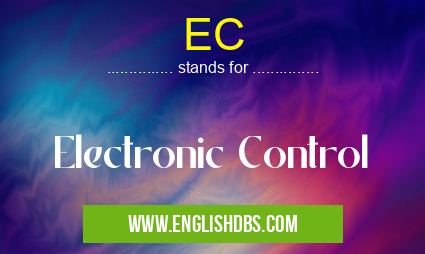What does EC mean in MANUFACTURING
EC stands for Electronic Control. It refers to the use of electronic devices to regulate, monitor, and manage various systems, processes, or machines. EC systems are designed to automate tasks, enhance efficiency, and improve overall performance.

EC meaning in Manufacturing in Miscellaneous
EC mostly used in an acronym Manufacturing in Category Miscellaneous that means Electronic Control
Shorthand: EC,
Full Form: Electronic Control
For more information of "Electronic Control", see the section below.
Introduction to EC
Applications of EC
EC is widely used in a diverse range of applications, including:
- Industrial automation: Monitoring and controlling production lines, robots, and other machinery
- Building automation: Managing lighting, heating, ventilation, and air conditioning (HVAC)
- Automotive industry: Engine management, transmission control, and safety systems
- Medical devices: Implantable pacemakers, surgical robots, and diagnostic equipment
- Consumer electronics: Smart home devices, smartphones, and wearable technology
Benefits of EC
Electronic Control systems offer numerous benefits:
- Increased efficiency: Automating tasks and optimizing processes can lead to significant efficiency gains.
- Improved accuracy: Electronic controllers can execute complex tasks with high precision, reducing errors.
- Enhanced reliability: EC systems are often more reliable than manual or mechanical controls, minimizing downtime.
- Flexibility: Electronic controllers can be easily reprogrammed or customized to meet changing requirements.
- Reduced costs: Automating tasks can reduce labor costs and minimize maintenance expenses.
Essential Questions and Answers on Electronic Control in "MISCELLANEOUS»MANUFACTURING"
What is Electronic Control (EC)?
Electronic Control (EC) is a technology that uses electronic components to regulate and control various systems and processes. It involves the use of sensors, microcontrollers, and other electronic devices to monitor and adjust parameters such as temperature, speed, and pressure.
How does EC differ from traditional mechanical controls?
EC offers several advantages over traditional mechanical controls. It enables precise control and adjustment of parameters, improved energy efficiency, reduced noise and vibration, and increased reliability. Additionally, EC systems are often more compact and easier to integrate into complex systems.
Where is EC commonly used?
EC is widely used in a variety of industries and applications. Some common examples include:
- HVAC systems (heating, ventilation, and air conditioning)
- Electric motors and drives
- Lighting systems
- Process control
- Automotive systems
What are the benefits of using EC?
The benefits of using EC include:
- Improved energy efficiency
- Enhanced control and precision
- Reduced noise and vibration
- Increased reliability
- Compact design and easy integration
Are there any limitations to using EC?
While EC offers numerous advantages, it also has some limitations:
- Higher initial cost compared to traditional mechanical controls
- Potential for electronic failures
- Requires skilled personnel for installation and maintenance
Final Words: EC (Electronic Control) is a crucial technology that plays a vital role in modern systems and devices. It enables automation, enhances efficiency, improves accuracy, increases reliability, and reduces costs. As technology continues to advance, EC systems will become even more sophisticated and integral to our daily lives and industries.
EC also stands for: |
|
| All stands for EC |
